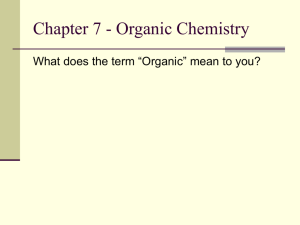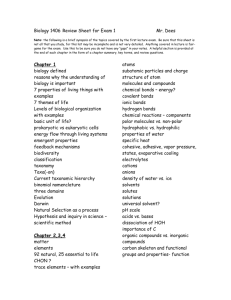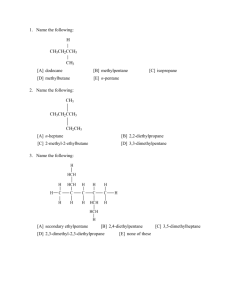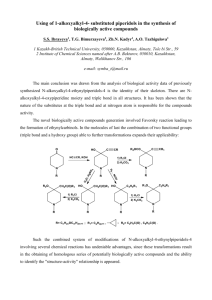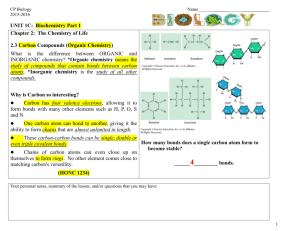General Chemistry Chapter 3 Note Packet
advertisement
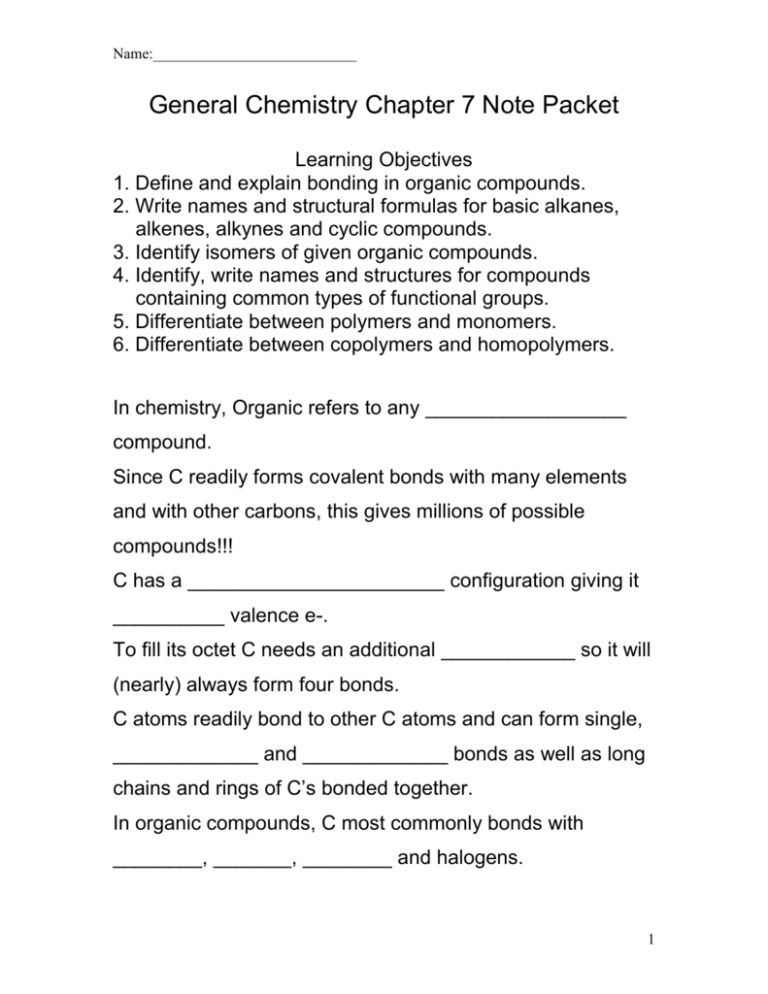
Name:___________________________ General Chemistry Chapter 7 Note Packet Learning Objectives 1. Define and explain bonding in organic compounds. 2. Write names and structural formulas for basic alkanes, alkenes, alkynes and cyclic compounds. 3. Identify isomers of given organic compounds. 4. Identify, write names and structures for compounds containing common types of functional groups. 5. Differentiate between polymers and monomers. 6. Differentiate between copolymers and homopolymers. In chemistry, Organic refers to any __________________ compound. Since C readily forms covalent bonds with many elements and with other carbons, this gives millions of possible compounds!!! C has a _______________________ configuration giving it __________ valence e-. To fill its octet C needs an additional ____________ so it will (nearly) always form four bonds. C atoms readily bond to other C atoms and can form single, _____________ and _____________ bonds as well as long chains and rings of C’s bonded together. In organic compounds, C most commonly bonds with ________, _______, ________ and halogens. 1 Name:___________________________ Hydrocarbons are the most basic class of ___________ compounds. They are compounds composed of _______ and ________ only Since the C-H bond is non-polar, hydrocarbons are ____________________ compounds. Compounds with only single bonds are called ______________ and end with “ane”. ie. ____________ Compounds with at least one double bond are called ______________ and end with “ene”. ie. ____________ Compounds with at least one triple bond are called ______________ and end with “yne”. ie. ____________ Compounds with a ring structure have the prefix _______________ ie. _________________ In writing formulas for organics we always use the molecular formula (although it may sometimes also be the empirical formula). Ex: acetylene is written ____________ not __________ It is often more useful to write out the structural formula which shows in what order the atoms are bonded to each other. Ex: Propane ____________ Structural: 2 Name:___________________________ Types of representation: propane Molecular formula – ____________________ Structural formula – Fully drawn Structural formula – abbreviated ____________________ Ball and stick Skeletal structure – change direction at each C – only __________________ features are shown Isomers – Are compounds which have the same _________ formulas but different _______________. These are very common in organic chemistry which is why we don’t normally use molecular formulas to show a specific compound. Ex: C6H12 isomers 3 Name:___________________________ The written names for organics can be very long. This is because the name describes the _____________________ of the molecule. The rules for naming compounds are given by the IUPAC. ________________ are used in the names to tell where on the molecule a certain feature is located. Ex: The basis of naming organic compounds (organic nomenclature) is identifying the C backbone or _________ and then telling what is attached to it and ___________. The number of C’s chained together are given by the following prefixes: Number of carbons 1 Prefix Number of carbons 6 2 7 3 8 4 9 5 10 Prefix 4 Name:___________________________ To name a simple hydrocarbon, choose the prefix that tells how many C’s are in the chain and then add the ending that indicates all single bonds. Ex: 1 carbon = ___________ all single bonds = ________ name = _______________ 3 carbons = _________ all single bonds = __________ name = ________________ If there are ___________ or ___________ bonds in the molecule indicate it by using the ene or yne endings. You must also tell where the multiple bond is by using numbers. Ex: 4 C’s and a double bond= __________________ The double bond starts on The double bond starts on the 1st C, the 2nd C, _____________ _______________ The carbons are numbered from one end to the other so that the C where the double bond starts has the _____________ number possible. 5 Name:___________________________ Practice: Name or draw the structure for the following Heptane 2-pentyne Branched hydrocarbons are compounds where the C’s are not all in a straight chain. Count the __________________ possible and use this as the “backbone” of the molecule. Use the same numbering rules as previously and tell what C chains are attached to the backbone and where. Side chains use the C number prefix and a “yl” ending. Ex: The longest chain has 5 C’s and no double bonds ___________________ there is a 1 C group (methyl) on the 3rd C in the chain. ________________ 6 Name:___________________________ Ex2: The longest chain has _________ C’s, no multiple bonds so, _____________ On the 4th C, there is a 2 C group – ___________ Also on the 4th C there is a 1 C group - _______________ _____________________________ Mixed branching and multiple bonds! Find the longest chain, tell what and where the features are. Longest chain is 5 = _____________ Double bond on the 2nd(!) C = _____________________ A 1 C group on the 3rd C = _________________________ Practice: Name the following _____________________________ Draw the structure for: 3-ethyl-4-methyl-1-hexyne 7 Name:___________________________ For ring structures, C number 1 is where the 1st feature starts, then count clockwise around the ring 6 C ring with a double bond ___________________ C number 1 is where the double bond starts so the methyl group is on C number 3 ____________________________ Functional groups are atoms or groups of atoms that are attached to the hydrocarbon chain. The addition of a functional group can greatly change the _______________ of the compound. Functional groups can contain any element but the most common ones contain ________, ______, _______, and halogens. Common Functional Groups: Halide – A halogen attached to the chain. The ___________ will always have only 1 ___________ bond. Named as: fluoro, chloro, bromo, iodo Ex: 1-chloroethane 8 Name:___________________________ 2,3-dibromo-1-butene 1,2,3-trifluoropropane Alcohol – Contain the group O-H bonded to C. Designated by an ____________ suffix (or a “hydroxy” prefix). The O is bonded to the chain. Ex: ethanol 1-propenol 2-methyl-3-hexanol 1,4-cyclohexadiol Amine – Contain an NH2 group bonded to the chain. Amines are named by the prefix _______________ The N is bonded to C. Ex: 2-amino propane 9 Name:___________________________ 2-amino-1-pentene 3-amino-1-butanol Ether – Contains an O in the ________________ bonded to 2 different C’s. Named by telling what is on each side of the O and then the word “ether” Ex: methylethyl ether diethyl ether Aldehyde – Contains an O ______________ bonded to the 1st or last C in the chain. Named with the suffix “al”. Ex: propanal 2-methyl butanal 10 Name:___________________________ Ketone – Contains an O doubly bonded to a C that is not at the end of the chain. Named with the suffix ___________ (pronounced “own”). Ex: propanone 2-hexanone 3-chloro-2-heptanone Carboxylic Acid- Contains the group where the C has an O and an OH bonded to it. The C is also bonded to the chain. Named with the suffix _______________ Ex: propanoic acid 3-amino hexanoic acid 1-fluoro butanoic acid 11 Name:___________________________ Polymers A polymer is a molecule that is composed of a __________ molecule bonded to itself over and over again to form a huge molecule. Polymers can have _____________ of units bonded together. A monomer is the _______________ unit used to make up a polymer. A great many different additives are mixed into polymers to alter their _________________. These include pigments, fillers, plasticizers (phthalates). Crosslinking agents- bind polymer strands together. Homopolymers –Only _______________ of monomer A – A – A –A – A Copolymers – __________________ monomers A–B–A–B–A Making polymers: Addition – monomers add together – no compounds released in reaction. Condensation – monomers add with _______________ released in reaction – often water Types of polymers: List at least 10! 12


